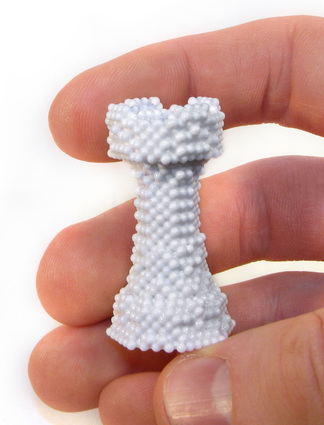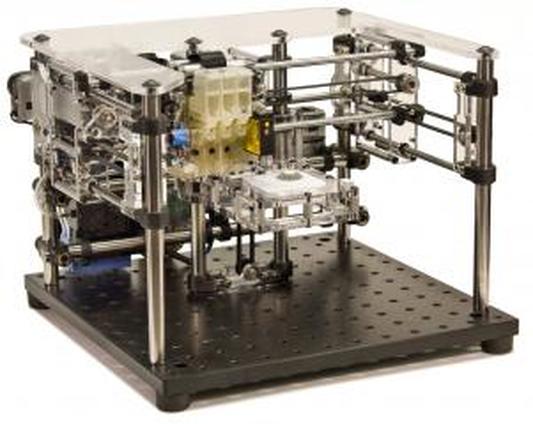
An example of a Voxelfab object by Jon Hiller.
A voxel is a 3D pixel. A unit of 3D dimensional space, a voxel can be a virtually demarcated space in a 3D file or it could be somewhere on a physical object. Voxels can be assigned values relating to the single point that they represent. You could describe a voxel’s density, color, conductivity etc. all as related to that single point that you identify. That one point is then located precisely. Voxel as a concept is easy enough to understand, but it is underutilized in 3D printing at the moment. Voxels let us imagine a world where everything is made up of discrete Lego blocks that we can identify and assign properties to. If we’re thinking of a programmable physical world then this as a concept is very exciting. Instead of the world being a pancake mix where a material might be malleable and changeable when you make it, the world is definable at every single point. Materials are not just a sludge that we pour out, to harden and become things. Materials can be defined not only on aggregate but with individual characteristics at every single location.
If we’re talking about gradient materials where we can change the density of a 3D printed part as well as its flexibility and hardness we can see that as an industry we are already looking at this space. Functionally graded (or gradient) materials are emerging. Stratasys Objet printers are already able to look at the voxel and what characteristics it may have. Envisiontec already looks at how it can harden a particular voxel of a resin bath. As a design idea, its also represented well by all of the pixel art type of stuff that cool folks put out. If we look at the papers of Jon Hiller and Hod Lipson however from years ago then we’re still a bit behind. Papers about 3D printing self-aligning parallel voxel manipulation and tunable material properties for 3D voxel printers are still not commercialized. Their continuation of a concept by Gershenfeld (I’m sure of it but I can’t find it anywhere online) is still fresh to most of us. Their ideas and research into cellular machines go much further still and imagine billions of micron-sized building blocks being assembled into parts.Even though initial voxelfab machines have been created the thinking to continue this in the industry is simply not there. I’ve been enamored with the voxelfab idea for a long time now. Indeed that’s why my consultancy and blog are called Voxelfab. The idea of being able to program, select and assign properties to every little Lego block you used to build something still blow my mind. How idiotic is our current way of building and making things? I take a block that has the characteristics I want and cut out the shape I need. Or I take a material and slather it on a layer by layer. It’s just silly. So imprecise and limiting. There are encouraging signs though that the age of the voxel will emerge. But, rather than making the voxels first, in an efficient lithographic process for example and then assembling them in a “select, assign, scoop, deposit” process to a point in a part it is microstructure control that comes the closest now to looking at the voxel.

Jon Hiller’s Voxeljet (2008)
The metal 3D printing people have found that by changing the variables of their process they can control individual microstructures which can then give their parts different properties. The melt pool, melt pool velocity, feed rates, temperatures, spot size and all of the variables inside the melt pool are being looked at. Companies such as Digital Alloys talk about being able to determine where each voxel is to determine final part properties. A big trend in papers is in microstructure control of metal printing. Gold nanostrctures are being 3D printed, looking at nano sized structures through the nanoscribe and other machines, we’re looking at how build orientation influences microstructure, seeing colonies of cells in metal prints, EOS’s to be released LaserProFusion technology points a million lasers at discrete points in a build to harden that one point. One could see LaserProFusion being used to create different characteristics of voxels at each point. By taking the pancake batter and pouring power into it the metals people are trying hard to make voxels out of the soup and gloop that our world is made out of.

Whilst OEMs and researchers are thinking of this it is designers who are really lagging. Let’s take a great example: Steve Wood’s variable density insoles. In these, we can take unique pressure pad and scan data to vary the infill in an FDM (material extrusion, FFF if you’re a tool) print. This infill itself is a pattern such as a hexagon. This means that in these insoles we’re creating a unique material just for one of your feet and your walking mechanics/issues. This is an exciting and totally doable thing that will in and of itself change footwear forever. But, what if we went a step further still and were able to consider FDM infill, not as a (often randomly chosen) pattern but a true 3D pattern that we can change at every point? What if we vary this pattern and the infill all throughout the build? What if we control the voxel that hardens out of our nozzle as well? Much more directly by cooling or heating it directly? What if in FDM we can at the single point control exactly what we are building? What if in addition to the temperature we can also precisely control for the shape of the voxel being deposited as it is deposited and then also vary the pattern in which it is deposited. Cray cray idea right? But, that would let us do the same. This would let us create a single material at every single point in a print. Every point would be ideally suited to its purpose. Everything would be a unique material best made for what it should be. This explains my obsession with the idea of “crystallization on the fly” in polymers. What if we could go from building an object one layer at a time to building an object one voxel at a time? This would let us completely change how things are made. To me voxelfab is still the complete dream outcome of what we should be able to do and a decade in the darkness I can see outlines of it emerging. At Every Unique Voxel a Unique Design and Material Best Suited for That Point and Application. Will you take up the torch?

71 Replies to “At Every Unique Voxel a Unique Design and Material Best Suited for That Point and Application.”
Comments are closed.